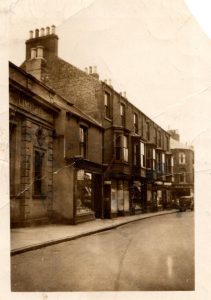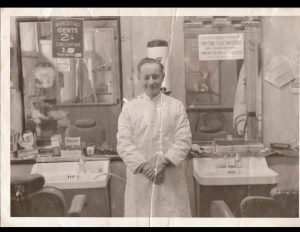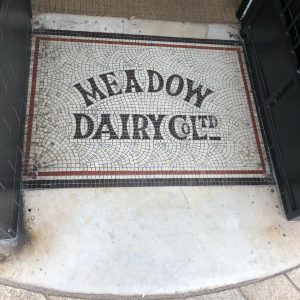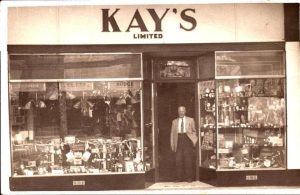
Today I was chatting to Gordon Sylvester whose father had Fred’s Barber’s on Sea View Street. It was prompted by my sharing a photo on a local Facebook group, asking for memories of shops in the area where The Seaside Girls books are set during the 1940s.
He took me for a walk down memory lane. We started at the Cliff Hotel, popped into the High Cliff Stores next door, past the Nottingham pub, the alleyway, White and Welton – haberdashery, ‘curtains and the like’, the Midland bank and the barber’s shop.
At the back of Fred’s was a brick building where a certain Mr Press made his ice creams. Now that’s the kind of neighbour I’d like to have.

Gordon recalled Croft’s, the bakers, which chimed with something June Crossley wrote on the group:
There was a bakery that used to back onto our yard in Wardall Street. They would put misshapes of the cakes on the wall for me and my little sister.’
Oh, what little treats and luxuries they must have been. Small kindnesses. It reminded me of our neighbour, Mrs Wheeler, who used to pass bottles of milk and bread over the wall to my mum when there were shortages of both in the 1970s. There’s nothing new about shortages – we only had tomatoes in season – and don’t get me started on strawberries.
Trevor Ekins has already told me some fabulous detail (which is stored away for later use!) of his grandfather, Frank Marfleet, who owned the sweet shop and confectioners at numbers 19 and 21 Sea View Street.
He embarked on a life in business in 1920 when, at the age of 20, he opened the original refreshment kiosk on the boating lake; the site of the present day kiosk. In 1926, he opened a confectioners on High Street and two years later he purchased the properties in Sea View Street. 1928 also saw him acquiring the concession to sell refreshments within the bathing pool and in 1932, he opened another confectioners on Alexandra Road, which I believe was in proximity to the Empire Theatre.’
Most popular were the memories of Tommy Rowston’s on the corner opposite the greengrocer, Saundby Gray’s. Wendy Parkinson says it
had very little space to even get into the shop, was open just about 24hrs and stocked everything from pin to an elephant! Could always rely on getting what you needed from there.’
Watmough’s, the newsagent was remembered by cousin Tommy Victory who delivered newspapers for them. Staggs ladies corsets and ladies underwear, Mr Stagg wearing his RAF tie and a waistcoat, a tape measure permanently about his neck, ‘a real gent.’ Gregory’s barbers on the other side of the road. Mr Turner the butcher with his blue and white striped apron. I remember my nanny calling in the butchers on Sea View Street and coming back with ham hock and chitterlings to share with dad, and talking about pig’s trotters – and from where you could always buy a lovely bit of tripe for tea.

There was the Meadow Dairy on the corner which still has the tiled entrance floor bearing its name. The Salvation Army on Cambridge Street, opposite the Queen’s pub on the opposite corner. I’m waiting on confirmation that Mrs Pumphrey’s Sweet shop was somewhere on Cambridge Street going towards Humber Street. A gem of a name for a shop. I can see her now, with her plump arms and her cheery face. Then again she could have been a pinch-faced battle-axe. I can make her what I like in my imagination but I’d have to change her name!
Wardall Street
Running along the back of Sea View Street was Wardall Street where we find Joe Pogson, the blacksmith. John Willis
used to pump the bellows on a Saturday morning in exchange for sixpence. The smith was a tiny man who hardly looked as if he had the strength to be wielding hammers. His party trick was to take a piece of wire and beat it on his anvil until it glowed red hot!’
On the corner of Wardall Street was Houghton’s hardware shop (always smells of paraffin), Pete Wallace recalls.
At the corner where the Fisherman’s is there was a green grocer, Saundby Gray. That shop is now part of the pub but the original entrance to the Fisherman’s is still there a few feet away from the present door and now used as an emergency exit.’

There was a corner shop just round the corner from Sea View Street called Wilsons’ wrote Sharon Booth-Howie ‘Mr Wilson would delivery groceries on his bike. He always gave me, and other kids, a broken biscuit or a sweet when we went in with our mums to order the groceries.’
And Maureen Silcox painted a marvellous picture in my mind of Rickards, an off-licence on the corner of St Peter’s Avenue and Highgate.
Mr Rickard used to stand at the door looking at the clock on the chemist shop opposite. Waiting for 10 pm closing time.’
Each and every description is only a few lines but what marvellous images they recreate, of a time and characters long gone. It’s only a clutch of streets but each one was peopled with proud shopkeepers – but that was before the supermarkets came along. I use online shopping so I can’t complain, given the convenience, but if we could turn back time… would we go back? To talk to real people, to browse among the goods on offer? To wait. We’re not very good at waiting anymore, we haven’t had the practice we once had – to stand in line while people pick and choose, faff and dither, earwig on the gossip – but oh, how much we have lost.
I think I’d rather wait.
